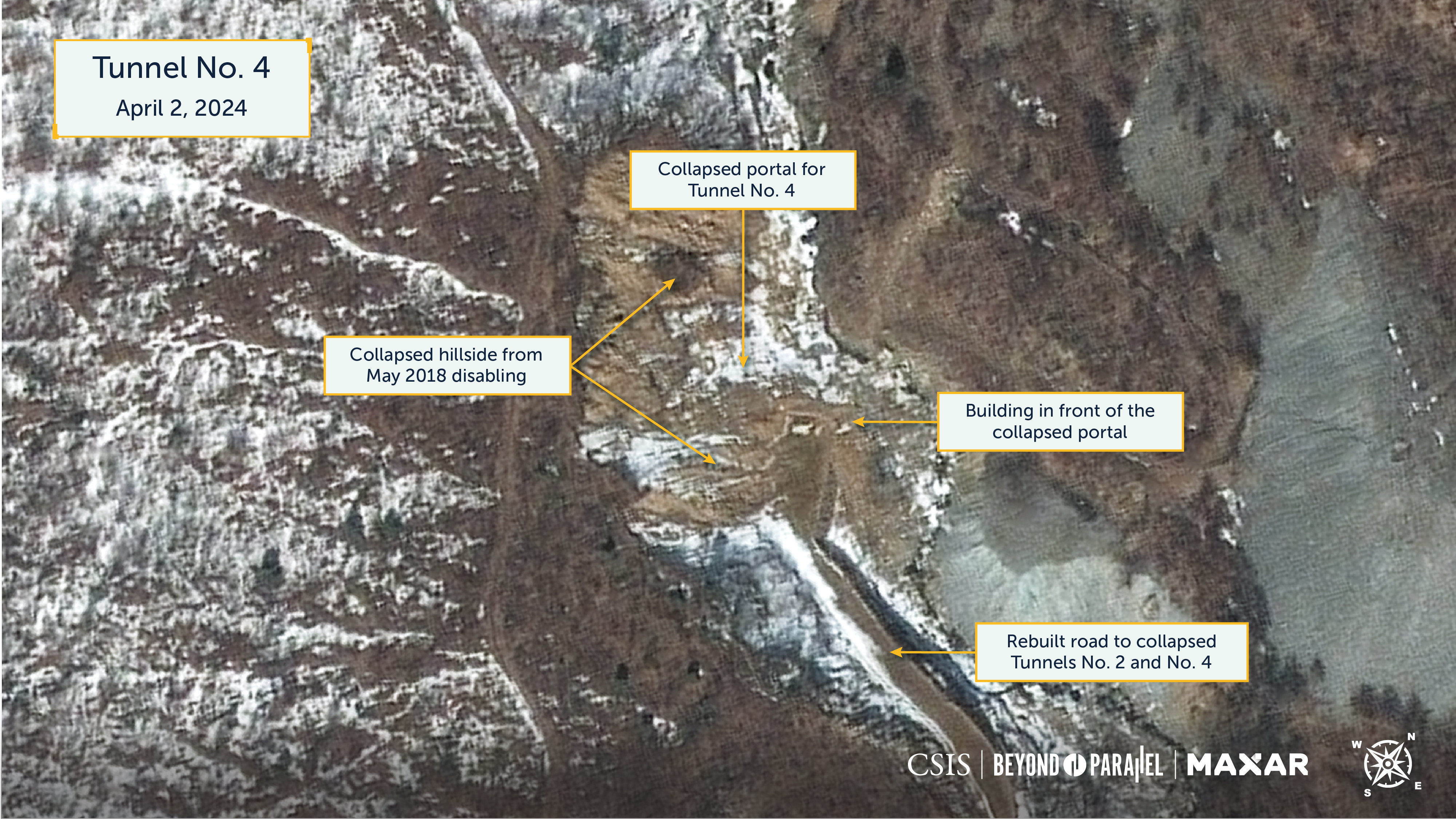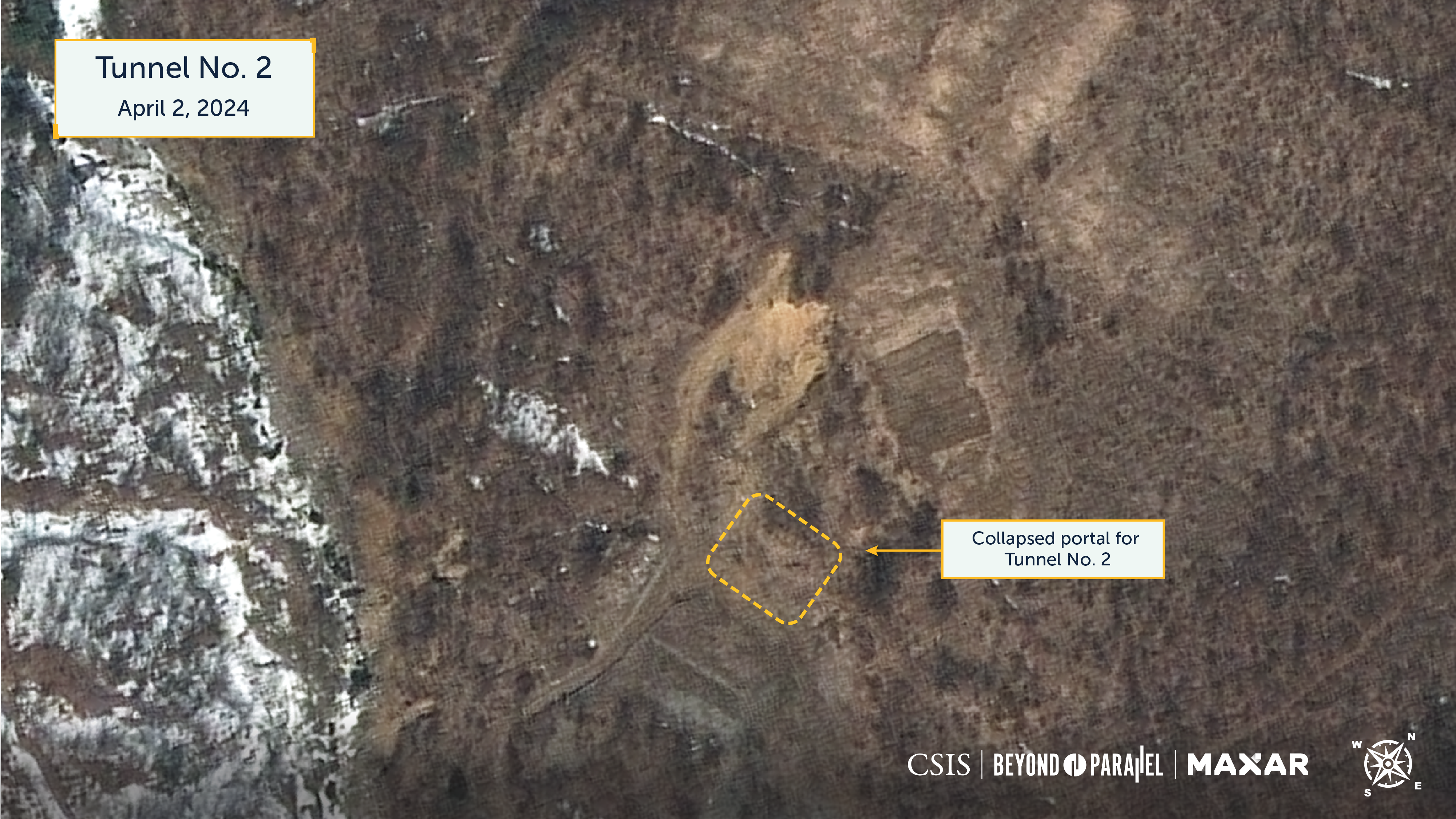
Recent Activity Observed at Punggye-ri Nuclear Test Facility

Key Findings
- A satellite image of the Punggye-ri Nuclear Test Facility acquired on April 2, 2024, shows that the road leading into the portal for Tunnel No. 3 has been cleared of snow, indicating continuing low-level activity within the tunnel.
- At a minimum, it indicates that North Korea continues to be committed to maintaining the progress already achieved in the reenabling of Tunnel No. 3 and the general health of the facility.
- Any activity in or around Tunnel No. 3 is always of concern as both the United States and South Korea have assessed North Korea as having completed all the required preparations for conducting a seventh nuclear test from the tunnel.
- No activity of significance is observed at the collapsed portals to Tunnels No. 1, 2, and 4.
Overview
An April 2, 2024, satellite image of the Punggye-ri Nuclear Test Facility, identified as the “Northern Nuclear Testing Site” by North Korea, shows that the road leading into the portal for Tunnel No. 3 is clear of snow, indicating ongoing activity. While the nature of this activity is unknown, at a minimum, it indicates that North Korea continues to be committed to maintaining the progress already achieved in the reenabling of Tunnel No. 3 and the general health of the facility.
As noted in previous reports, any activity in or around Tunnel No. 3 is always of concern as both the United States and South Korea have assessed North Korea as having completed all the required preparations for conducting a seventh nuclear test from Tunnel No. 3 since 2020.1
While the recently observed activity does not suggest imminent preparations for a seventh nuclear test, the reasons remain unknown. The decision to conduct the test remains entirely within the hands of Kim Jong-un. It will likely be undertaken to maximize his perceived political objectives. The actual timing between a decision to test and the test itself may be relatively shorter than many believe as most of the preparations have already been completed and those that aren’t can easily be accomplished at night or under periods of inclement weather.

provides an excellent idea of the steepness of the valleys in which the northern test area is located. Click to enlarge. (Copyright © 2024 by Maxar Technologies) Image may not be republished without permission. Please contact imagery@csis.org.
Tunnel No. 3
Last week’s April 2, 2024, satellite image shows that the road leading into the portal of Tunnel No. 3 (South Portal) has been cleared of snow, indicating continuing low-level activity within the tunnel.

Main Administration and Support Area
No vehicle, personnel, or recent ground activity is observed within the main administration and support area or the adjacent buildings.

Tunnels No. 2 and No. 4
While the rebuilt road leading north from the main Administrative and Support Area to the collapsed portal for Tunnel No. 4 (West Portal) is clear of snow, the section of the road going further north to the collapsed portal for Tunnel No. 2 (North Portal) remains snow-covered. The portals themselves generally remain as they have been since at least April 2023.


Tunnel No. 1
As expected, the January 16, 2024, image continues to show no activity at Tunnel No. 1 (East Portal), which has been abandoned since being used for North Korea’s first nuclear test on October 9, 2006, and is believed to have collapsed.

References
- “U.S. assesses North Korea could be ready to conduct a nuclear test this month,” Reuters, May 6, 2022, https://www.reuters.com/world/asia-pacific/us-assesses-north-korea-could-be-ready-conduct-nuclear-test-this-month-2022-05-06/; “Bermudez Jr., Joseph S., and Victor Cha,” Punggye-ri Nuclear Test Site: Imagery Supports ROK and U.S. Government Reservations about Permanent Disablement,” Beyond Parallel, October 17, 2019, https://beyondparallel.csis.org/punggye-ri-nuclear-test-site-imagery-supports-rok-and-u-s-government-reservations-about-permanent-disablement/; and Gwee-Geun Kim and Joon-Sam Lee, “N. Korea able to use Punggye-ri nuke testing site after restoration work: JCS,” Yonhap News, October 8, 2019, https://www.yna.co.kr/view/AKR20191008147151504. ↩
